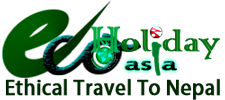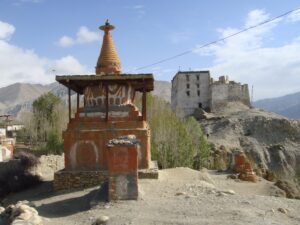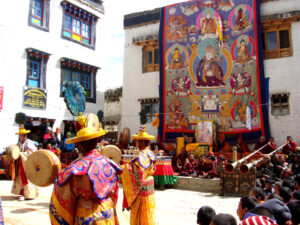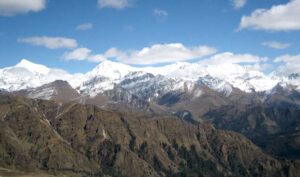About This Tour
Dudhkunda, also known as Dudhpokhari, sits majestically at an altitude of approximately 5,300 meters above sea level, while Thurchu, the base camp of Dudhpokhari and Namun La Pass, marks the geographical center of Lamjung, Manang, and Kaski Districts, boasting an altitude of around 4,500 meters above sea level.
This hidden jewel remains relatively undiscovered, making it one of the world's most picturesque yet least-trekked destinations. Dudhkunda offers a perfect blend of natural beauty and rich cultural experiences, providing an enticing prospect for adventure enthusiasts seeking new trekking routes in the Annapurna Region of Nepal.
The Khaling Rais, the predominant community in this region, add to the unique charm of Dudhkunda. With their distinct language, the Khaling Rais are known for their proactive engagement in both joint and nuclear family ties. Their cultural identity is reflected in rituals such as the Bhume Dance, the Chandi Dance, and the Naghi Pooja, while Chhan, a locally fermented millet/rice wine, is an integral part of their cuisine and traditions.
The highlanders firmly believe in worshipping their ancestral deities and the earth to ensure the continuity of human existence. Despite their affiliation with the Kirant ethnic group, the Khaling Rais enthusiastically celebrate Hindu and Buddhist festivals, showcasing the harmonious blend of diverse cultures in this remote Himalayan enclave.
Highlights
- Explore the pristine Dudhkunda (Milk Pond) at an altitude of 5,300m.
- Experience the unique culture of the Khaling Rai community.
- Trek through the untouched beauty of Lamjung, Manang, and Kaski Districts.
- Visit Thurchu, the base camp of Dudhpokhari, and Namun La Pass.
- Witness traditional rituals like Bhume Dance, Chandi Dance, and Naghi Pooja.
- Immerse in the rich cultural tapestry of the Kirant ethnic group.
- Enjoy the breathtaking views of Annapurna Region landscapes.
- Trek on an off-the-beaten-path, rarely explored by tourists.
- Discover the diverse flora and fauna of the high-altitude region.
- Experience the warmth of local hospitality in the remote Himalayan villages.
What’s Included
- Professional trekking guide and support staff.
- All necessary permits for the trek.
- Accommodation in teahouses or tents during the trek.
- Three meals a day during the trek.
- Ground transportation as per the itinerary.
- Porter service for carrying luggage.
- First aid kit and emergency evacuation arrangements.
- Cultural experiences with local communities.
- International airfare to and from Nepal.
- Nepal visa fees.
- Travel and medical insurance.
- Meals and accommodation in Kathmandu.
- Personal trekking equipment.
- Additional expenses due to unforeseen circumstances.
- Tips for guides, porters, and support staff.
- Extra costs incurred in case of delays, cancellations, or other disruptions.
- Optional activities and entrance fees not mentioned in the itinerary.
Tour Plan
Expand allCollapse allArrival in Kathmandu
Your journey begins as you arrive in Kathmandu, the capital city of Nepal. Transfer to your hotel, settle in, and prepare for the adventure ahead. Spend the day exploring the vibrant streets of Thamel or relaxing in the hotel.
- Altitude: Kathmandu (1,400m)
- Meal: Welcome Dinner
- Accommodation: Hotel
- What to See:
- Thamel's bustling atmosphere
- Local markets and shops
- Kathmandu's cultural richness
- Checklist for Today:
- Ensure all necessary documents
Kathmandu to Phaplu (2,469m)
Fly from Kathmandu to Phaplu, a scenic mountain airstrip. Upon arrival, acclimate to the altitude, explore Phaplu, and get a taste of the Sherpa culture. Prepare for the trek, and enjoy a peaceful evening in the mountains.
- Altitude: Phaplu (2,469m)
- Meal: Breakfast, Lunch, Dinner
- Accommodation: Lodge/Teahouse
- What to See:
- Aerial views of Himalayas
- Sherpa cultural immersion
- Phaplu's serene surroundings
- Checklist for Today:
- Flight essentials
- Short acclimatization walk
Phaplu to Beni (3,143m)
Embark on a scenic trek from Phaplu to Beni. Traverse rolling hills, picturesque landscapes, and charming villages. Immerse yourself in the beauty of nature and the unique Sherpa way of life.
- Altitude: Beni (3,143m)
- Meal: Breakfast, Lunch, Dinner
- Accommodation: Lodge/Teahouse
- What to See:
- Rolling hills and valleys
- Sherpa villages
- Diverse flora and fauna
- Checklist for Today:
- Comfortable trekking gear
- Water bottle and snacks
Beni to Dudhkunda (4,560m)
Trek from Beni to Dudhkunda, a sacred lake surrounded by majestic landscapes. Traverse alpine meadows, dense forests, and high mountain passes while enjoying breathtaking views of the Himalayas.
- Altitude: Dudhkunda (4,560m)
- Meal: Breakfast, Lunch, Dinner
- Accommodation: Teahouse/Camping
- What to See:
- Dudhkunda Lake
- Alpine meadows
- Panoramic Himalayan views
- Checklist for Today:
- Warm clothing
- Camera for scenic views
Dudhkunda to Pauwa Bas (3,600m)
Descend from Dudhkunda to Pauwa Bas, enjoying the changing landscapes. Pass through tranquil forests, witness diverse flora, and experience the unique beauty of the region. Reach Pauwa Bas and rest after a rewarding day.
- Altitude: Pauwa Bas (3,600m)
- Meal: Breakfast, Lunch, Dinner
- Accommodation: Teahouse/Camping
- What to See:
- Forested trails
- Flora and fauna
- Scenic mountain views
- Checklist for Today:
- Trekking essentials
- Rest for acclimatization
Pauwa Bas to Hille Bhanjyang to Nasim Pati
Embark on a journey through enchanting rhododendron forests, a hallmark of the Langtang region's biodiversity. Traverse the picturesque Hille Bhanjyang, a high mountain pass, and reach the serene Nasim Pati. The trek introduces you to the tranquility of the Himalayan wilderness, with breathtaking views unfolding at every turn.
- Altitude: Nasim Pati (3,650m)
- Meal: Breakfast, Lunch, Dinner
- Accommodation: Teahouse/Lodge
- What to See:
- Rhododendron forests
- Hille Bhanjyang mountain pass
- Nasim Pati's serene surroundings
- Checklist for Today:
- Adequate hydration
- Trekking poles for stability
- Enjoy the diverse flora





